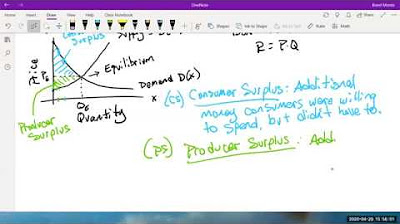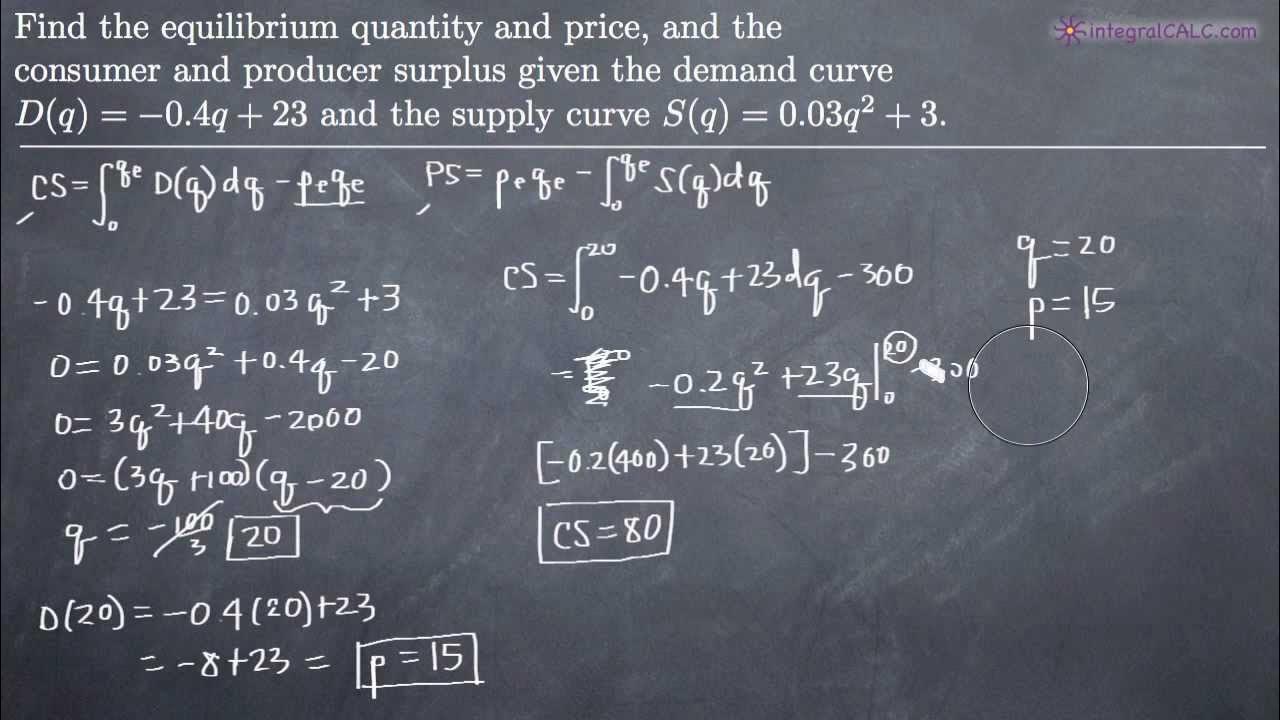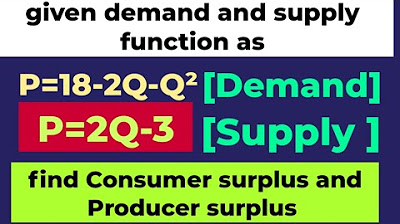Consumer Surplus (CS) and Producer Surplus (PS) Example
TLDRIn this educational video, Professor Money explains the concepts of consumer surplus and producer surplus using a demand and supply example. He begins by deriving the equilibrium point where the quantity demanded equals the quantity supplied, which is found to be 15 units at a price of $20 per unit. To calculate consumer surplus, he integrates the demand function from 0 to 15 units and subtracts the total revenue (price times quantity), resulting in a surplus of $225. For producer surplus, he integrates the supply function and subtracts the amount producers were willing to accept, which yields a surplus of $112.50. The video emphasizes understanding the formulas and their origins to better remember and apply them in economic analysis.
Takeaways
- 📈 The concept of consumer surplus and producer surplus is introduced, with a reference to another video for more background.
- 🧮 The equilibrium point is calculated by setting the demand and supply equations equal to each other and solving for the quantity of units (x = 15).
- 💲 At equilibrium, both the demand and supply prices are equal ($20 per unit), which is where producers are willing to supply and consumers are willing to purchase.
- 📉 Consumer surplus is calculated by integrating the demand curve from 0 to the equilibrium quantity and subtracting the total amount consumers actually spend ($225).
- 📈 Producer surplus is determined by subtracting the integral of the supply curve from the total revenue received by producers ($300 - $187.50 = $112.50).
- 💭 Consumer surplus represents the additional amount consumers are willing to spend but do not have to, which is a measure of their benefit from the transaction.
- 💼 Producer surplus represents the additional profit for the producer beyond what they were willing to accept, indicating their benefit from the transaction.
- ⚖️ Equilibrium is the point where the quantity supplied equals the quantity demanded at a given price, which is crucial for calculating surpluses.
- 📚 Understanding the formulas for calculating consumer and producer surplus is essential for economic analysis and can be reinforced through practice.
- 🔢 The script provides a step-by-step example of how to calculate both consumer and producer surplus using specific functions and integral calculus.
- 🤔 The idea of surplus is important as it reflects the additional value or profit that parties gain from a market transaction beyond their initial willingness to transact.
- 📈 The surpluses are graphically represented by the areas under the demand and supply curves, which are key to understanding market efficiency and welfare.
Q & A
What is the main topic of the video?
-The main topic of the video is to demonstrate an example of consumer surplus and producer surplus using a demand and supply curve.
What are the equations for demand and supply given in the video?
-The demand equation is D(x) = -2x + 50, and the supply equation is S(x) = x + 5.
How is the equilibrium quantity determined in the video?
-The equilibrium quantity is determined by setting the demand and supply equations equal to each other and solving for x, which results in x = 15 units.
What is the equilibrium price per unit?
-The equilibrium price per unit is $20, as both the demand and supply prices are equal at the equilibrium quantity of 15 units.
How is consumer surplus calculated in the video?
-Consumer surplus is calculated by integrating the demand curve from 0 to the equilibrium quantity and subtracting the total amount consumers actually spent (which is the revenue price times quantity).
What is the consumer surplus in the example provided?
-The consumer surplus in the example is $225, which is the difference between what consumers were willing to spend ($525) and what they actually spent ($300).
How is producer surplus calculated in the video?
-Producer surplus is calculated by subtracting the integral of the supply curve from 0 to the equilibrium quantity from the total revenue received by the producer (price times quantity).
What is the producer surplus in the example provided?
-The producer surplus in the example is $112.50, which is the difference between the total revenue ($300) and what the producer was willing to accept ($187.50).
What does the video suggest about the relationship between the supply function and producer surplus?
-The video suggests that there is some profit built into what the producer is willing to accept for the supply function, and the producer surplus represents this additional profit.
What is the significance of finding both consumer and producer surplus?
-Finding both consumer and producer surplus provides a comprehensive understanding of the total welfare generated in a market transaction, showing the additional amount consumers are willing to spend and the additional profit producers make beyond their minimum acceptable price.
What advice does the professor give for understanding and remembering the formulas for surplus?
-The professor advises to practice these calculations and understand where the formulas come from to make it easier to remember and apply them when needed, such as during a test.
Why is it important to understand the concept of equilibrium in the context of consumer and producer surplus?
-Understanding the concept of equilibrium is important because it represents the point where supply and demand meet, and it is the basis for calculating the surpluses, which are key measures of market efficiency and welfare.
Outlines
📈 Finding Equilibrium and Calculating Consumer Surplus
In the first paragraph, Professor Money introduces the concepts of consumer and producer surplus using a demand and supply example. The demand function is given as d(x) = -2x + 50 and the supply function as s(x) = x + 5, where x represents the number of units. To find the equilibrium, the demand and supply functions are set equal to each other, solving for x = 15 units at a price of $20 per unit. Consumer surplus is then calculated as the area under the demand curve from zero to the equilibrium quantity minus the total amount consumers spent (20 x 15 units). The integral from 0 to 15 of -2x + 50 is evaluated, resulting in a consumer surplus of $225, which represents the additional amount consumers were willing to spend but did not have to.
💰 Determining Producer Surplus and Understanding Profit
The second paragraph delves into the calculation of producer surplus. It is defined as the total revenue received by producers minus what they were willing to accept, which is found by integrating the supply function from zero to the equilibrium quantity. In this case, the revenue is 20 x 15 units, and the supply function is x + 5. The integral from 0 to 15 of x + 5 is evaluated, and the producer surplus is calculated as $300 (total revenue) minus (0.5 x 15^2 + 5 x 15), which equals $112.50. This surplus represents the additional profit for the producer beyond what they were willing to accept, indicating a built-in profit margin in the supply function.
Mindmap
Keywords
💡Consumer Surplus
💡Producer Surplus
💡Demand Curve
💡Supply Curve
💡Equilibrium
💡Price
💡Quantity
💡Integration
💡Revenue
💡Willingness to Pay
💡Willingness to Accept
Highlights
Professor Money introduces the topic of consumer surplus and producer surplus.
Reference to another video for background on consumer and producer surplus concepts.
Explanation of the demand curve (D) and supply curve (S) formulas.
Finding the equilibrium point where supply equals demand.
Solution to the equilibrium equation resulting in 15 units at a price of $20 each.
Verification of equilibrium by calculating both demand and supply prices at 15 units.
Introduction to calculating consumer surplus as the difference between what consumers are willing to pay and what they actually pay.
Integration of the demand curve to find the consumer surplus from 0 to 15 units.
Consumer surplus calculation resulting in an additional amount consumers were willing to spend but didn't have to.
Definition of consumer surplus as the additional amount consumers were willing to spend but didn't need to.
Transition to producer surplus, which is the revenue received minus what producers were willing to accept.
Integration of the supply curve to find the producer surplus from 0 to 15 units.
Producer surplus calculation showing the additional profit for the producer.
Explanation that producer surplus includes a profit margin over what producers are willing to accept.
Summary of the process: finding equilibrium, calculating consumer surplus, and producer surplus.
Advice to practice these calculations to understand the formulas for their practical use.
Wishing the audience good luck, emphasizing the importance of understanding the concepts for tests.
Transcripts
Browse More Related Video
5.0 / 5 (0 votes)
Thanks for rating:





